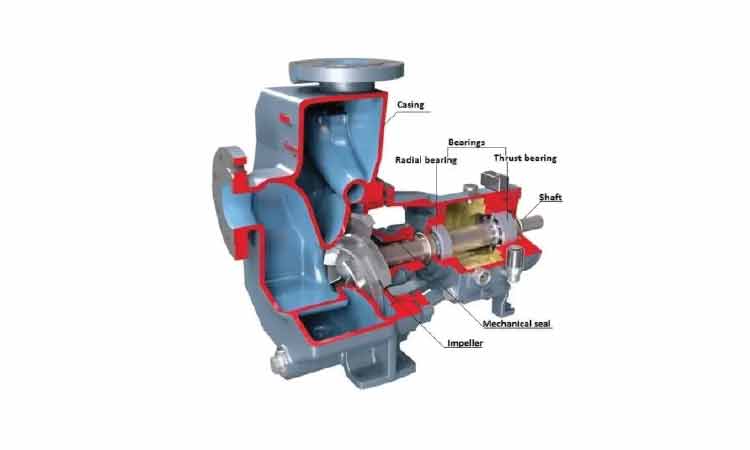Considerations for Design of Bearings for Pumps and Compressors
By Ajay Mishra, Head of Industrial Applications, NBC Bearings.
Bearings in pumps & compressors operate under demanding conditions, requiring careful design considerations to ensure efficiency, reliability, and longevity. These components are subjected to high loads, extreme speeds, elevated temperatures, contamination, and corrosive environments. Selecting the right bearing design is critical to mitigating these challenges and optimizing the overall performance of pumps and compressors.
Key Design Considerations
1. Speed and Friction Reduction
Pumps and compressors often operate at high rotational speeds, leading to increased friction and heat generation. Excessive friction can result in energy losses, premature wear, and reduced service life. Bearings must be designed to minimize rolling resistance and ensure smooth operation.
Design Strategies:
- Use of high-precision rolling elements to maintain optimal contact and reduce friction.
- Adoption of special polyamide or ceramic cages that lower inertia and enable stable high-speed operation.
- Implementation of optimized internal clearance to minimize skidding and heat buildup.
2. High-Temperature Resistance
High-speed applications generate considerable heat, which can compromise the structural integrity of the bearing materials and lubrication properties. Thermal expansion and degradation of cage materials must be addressed.
Design Strategies:
- Selection of temperature-resistant cage materials, such as high-performance polyamide or PEEK (polyether ether ketone).
- Use of heat-stabilized bearing steels and ceramic rolling elements.
- Incorporation of advanced lubrication systems with high-temperature synthetic greases or oil-air lubrication.

3. Corrosion Resistance
Many pumps and compressors handle liquids, chemicals, and moist air, making corrosion a major concern. Corroded bearing components can lead to increased friction, failure, and contamination of the system.
Design Strategies:
- Use of stainless steel or coated bearing components to enhance corrosion resistance.
- Application of hybrid bearings with ceramic rolling elements that are impervious to moisture and chemicals.
- Specialized sealing and shielding solutions to prevent the ingress of contaminants.
4. Load Handling Capability
Pumps and compressors exert substantial radial and axial loads on bearings. These loads can fluctuate due to varying operating conditions, acceleration, and deceleration forces.
Design Strategies:
- Optimized raceway geometry to distribute loads evenly & enhance load-carrying capacity.
- Use of angular contact bearings or tapered roller bearings for applications with significant axial loads.
- Strengthened cages with high shock-load absorption capacity, such as polyamide or brass variants.

5. Vibration and Noise Reduction
Noise and vibration are critical factors, especially in household or industrial applications where silent operation is preferred. Excessive vibration can also reduce bearing life by increasing fatigue stress.
Design Strategies:
- Precision manufacturing techniques to ensure tight dimensional tolerances and reduce eccentricities.
- Use of elastomeric damping elements in bearing housings to absorb vibrations.
Application of optimized surface finishes to minimize rolling noise and friction.
6. Energy Efficiency
Energy efficiency is a key consideration in modern pumps and compressors, as lower friction translates to reduced power consumption & operational costs.
Design Strategies:
- Improved accuracy in raceway design to minimize rolling resistance.
- Low-friction coatings on rolling elements & races to enhance efficiency.
- Integration of hybrid bearings with ceramic balls to reduce overall mass and inertia.
Material Selection for Bearings in Pumps and Compressors
Bearing Steel
Traditional bearing steels offer high load capacity and fatigue resistance but may require additional treatments to withstand extreme conditions.
Stainless Steel
For applications involving water or chemicals, stainless steel bearings provide enhanced corrosion resistance while maintaining structural strength.
Ceramic Bearings
Hybrid or full-ceramic bearings offer high-speed capability, superior wear resistance, and excellent corrosion resistance, making them ideal for aggressive environments.
Lubrication Considerations
Effective lubrication is essential for minimizing wear, reducing heat buildup, and ensuring smooth operation. Lubricant selection depends on temperature, speed, and environmental conditions.
Lubrication Strategies:
- Oil Lubrication: Suitable for high-speed and high-temperature applications, offering continuous lubrication and cooling.
- Grease Lubrication: Preferred for maintenance-free operation, with specialized greases designed for extreme temperatures and moisture resistance.
- Solid Lubrication: Employed in extreme environments where conventional lubricants may fail, using materials like PTFE or graphite composites.
Sealing and Contamination Control
Bearings in pumps and compressors must be protected from contaminants such as dust, dirt, moisture, and chemicals. Proper sealing solutions enhance reliability and longevity.
Sealing Options:
- Contact Seals: Provide effective protection against contaminants but may increase friction.
- Non-Contact Seals: Reduce friction while offering moderate contamination protection.
- Labyrinth Seals: Effective for high-speed applications where minimal resistance is required.
Surface Finish and Coatings
The surface finish of bearing components plays a crucial role in reducing friction, improving wear resistance, and enhancing performance in extreme conditions.
Enhancements:
- Superfinished raceways and rollers to minimize frictional losses and improve efficiency.
- Anti-corrosion coatings such as black oxide or phosphate treatments.
- DLC (diamond-like carbon) or ceramic coatings for extended durability.
Conclusion
The design of bearings for pumps and compressors requires a comprehensive approach that considers speed, temperature resistance, load capacity, corrosion resistance, and energy efficiency. By optimizing materials, lubrication, sealing solutions, and surface treatments, manufacturers can develop bearings that offer superior performance and longevity in demanding applications. Selecting the right bearing design not only enhances the reliability of pumps and compressors but also improves overall system efficiency & reduces maintenance costs.

The author, Ajay Kumar Mishra is the Head of Application Engineering at NBC Bearings, bringing over 17 years of experience in bearing applications and the steel industry. With deep expertise in engineering solutions, he plays a key role in optimizing bearing performance across various applications, driving innovation and efficiency for NBC’s customers.



